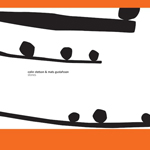|
|
 |
Dusted Reviews
Artist: Colin Stetson & Mats Gustafsson Album: Stones Label: Rune Grammofon Review date: Feb. 13, 2013 |

|
|
|
 |
Stones pits two of the world’s most visible saxophonists head-to-head and, given the pair’s reputation for strength and power, you’d be forgiven for being braced against 35 minutes of skronking bravura. If so, the opening moments of “Stones That Can Rest Heavily” (the album is split into four tracks, although they are essentially all one piece) will be a bit of a surprise. Oh, Stetson’s bass sax quickly fills the space with its deep rumble, but in contrast Gustafsson is a discreet player, sitting back and appearing to contemplate what to do in response to the extended, foghorn-like honks that Stetson drags out of his horn. When the Swede does ride in, it’s with a trilling counter-drone on his tenor that quickly forces Stetson to stretch out further before splintering into a typically unkempt solo that leaves the Canadian somewhat grasping at air.
In many ways, this 2-minute intro captures the album in miniature. There’s a sense that both players want to make the most of this collaboration, so their pace is occasionally tentative, even cagey, but their natural instincts to go for force quickly take precedence, at times to the detriment of any sense of melody or balance. The best moment of the entire album comes about a third of the way into the first segment, when Gustafsson retreats into a series of the faintest of repeated notes that contrast superbly with Stetson’s equally muted bass foundation. Occasionally, one of them darts forward for a brief surge of noise before retreating like a scared hyena to lie in wait again. It’s a passage that bubbles with pleasant tension, very much like the sort of tactic (the word feels apt) employed by electro-acoustic improvisers. Equally notable later on, although in a more upbeat manner, is when the two start trading percussive punctuations on their key-cups, resulting in a cheerful exchange of pizzicatos where any “real” notes are pleasant interruptions rather than intrusions, the fun being in the unpredictability.
But for the most part, the duo can’t seem to contain their desire to trade blows, as fast, heavy and rambunctious as you would expect. Gustafsson has the more varied tone, whilst Stetson is more restrained. Perhaps he was less indifferent to how their interactions should pan out, for better or worse. In full flight, they deliver some heady barrages of notes, but, for the most part, what ensues is a form on nondescript chaos. Recording an entire album with just one or more saxes is a tricky move, and neither Gustafsson nor Stetson has the discipline to equal, say, Anthony Braxton, who managed on For Alto to reach heights that these two can’t approach, even in tandem.
It is a rather dispiriting side-effect of the evolution of modern music that the saxophonist icon, such as a Parker or a Coltrane, no longer really exists like their parallels on the electric guitar or piano, and, in their own ways, Colin Stetson and Mats Gustafsson are among the closest we now have. So it’s nice that they’ve crossed oceans to deliver Stones. But, as is often the case, the idea of this partnership ends up being better than the result.
By Joseph Burnett
|







